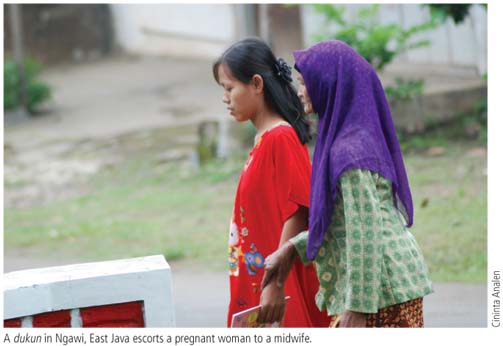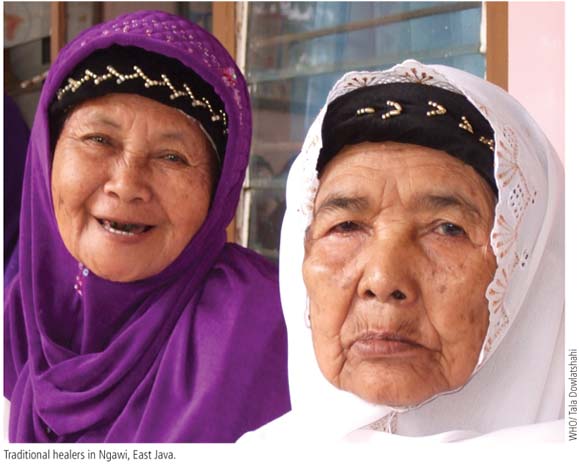NEWS
Saving mother's lives in rural Indonesia
Indonesia's maternal mortality rate is one of the highest in south-east Asia. One East Java district has introduced a novel scheme to reduce those deaths.
In many rural areas of Indonesia, traditional ways of delivering babies remain popular. For example, in Ugaikagopa in the country's east, traditional healers take the pregnant woman to the middle of the forest to deliver the baby. They may use fibres taken from bamboo to cut the umbilical cord and wipe the newborns' bodies with guava leaves.
The instruments used are not sterile and can lead to infection. The traditional healer, or dukun in Indonesian language or Bahasa, may not be able to deal with complications during labour, and by the time the mother gets to a local clinic it may be too late.
As a result, maternal mortality in Indonesia is high compared to most south-east Asian countries. In 2005, there were an estimated 262 maternal deaths per 100 000 live births, compared with 39 per 100 000 in Malaysia and 6 per 100 000 in Singapore. Figures for Papua province from 2003 show even higher death rates: 396 per 100 000 live births.
The chief cause of maternal death in Indonesia is bleeding, followed by eclampsia, infection, and the complications of abortion and prolonged labour. Most of these deaths occur with births handled by traditional birth attendants rather than by medically trained health-care professionals.
Many families prefer to use a dukun because of traditional beliefs and because it is a cheaper option than using a trained midwife or going to hospital. In addition, these traditional birth attendants do household chores while mothers recover.
A scheme in Ngawi district in East Java has been initiated to try to ensure that a midwife or other trained birth attendant assists deliveries. Since 2006, dukun are given incentives of up to IDR 100 000 (US$ 12) for referring pregnant women to skilled birth attendants or community-based midwives. Funding comes from the local government budget.

Mbah Dinah, 60, a traditional healer in Ngawi, said, "We escort the pregnant woman to the community health centre during daylight. At night, we escort them to the midwife's house."
Additionally, the dukun receive a small sum of money when they assist a midwife. They are responsible for taking care of the cord and for bathing the newborn supervised by the midwife during the first week. The patient makes the payment; the amount depends on the length and type of services provided.
This way, dukun do not feel threatened by the arrival of a skilled birth attendant or community-based midwife in their area, but are happy to cooperate.
Sumarih, 24, is from the village of Majaseem and was nine months pregnant. She said she preferred to be examined and give birth aided by a midwife because she feels it is safer: "Devices that are used are sterile and midwives know how to handle any complications fast." She was examined monthly in early pregnancy, and every week in the ninth month.

The scheme is proving successful. In 1984, a total of 86% of deliveries in Ngawi were aided by dukun, compared with fewer than 1% of deliveries today. Maternal deaths also have decreased: while 15 mothers died during delivery in 2002, this number dropped to 9 in 2006.
Awareness of the risks of delaying transfer of pregnant women to health centres also has grown as a result of the Program Gerakan Sayang Ibu (To Love Mother Programme in Bahasa). This information programme prompted many villages to provide transportation to transfer pregnant women either to community health centres or midwife delivery huts.
These initiatives are part of WHO's Making Pregnancy Safer strategy, which was launched in 1999 with support from the United Nations Population Fund (UNFPA), the United Nations Children's Fund (UNICEF) and the World Bank. Making Pregnancy Safer in Indonesia has three key principles: every delivery should be attended by a skilled birth attendant, every complication should be referred and managed appropriately, and all reproductive-age females should have access to contraceptives and post-abortion care. The Indonesian government has set a target to lower the maternal mortality rate to 125 per 100 000 live births by 2010.
The ministry of health initiated a midwifery education programme from 1989 to 1996 that trained more than 54 000 community-based midwives. Due to this programme, the proportion of deliveries assisted by a skilled attendant throughout Indonesia has risen from 25% in the early 1990s to 76% in 2006.
"We know what interventions are necessary in order to save pregnant women and newborns' lives," said Dr Monir Islam, Director of the Making Pregnancy Safer department at WHO. "The technical battle we have won; now the time has come to win the political battle for policy changes and increased investment." 
Cininta Analen, Ugaikagopa
